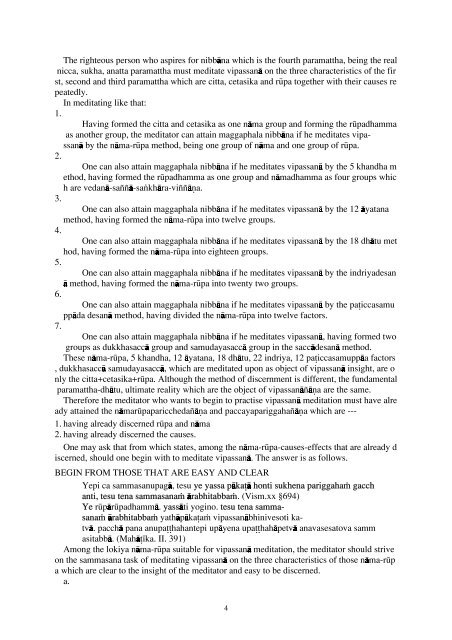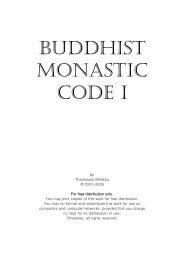Vipassana Kammatthana.pdf
Vipassana Kammatthana.pdf
Vipassana Kammatthana.pdf
Create successful ePaper yourself
Turn your PDF publications into a flip-book with our unique Google optimized e-Paper software.
The righteous person who aspires for nibbåna which is the fourth paramattha, being the real<br />
nicca, sukha, anatta paramattha must meditate vipassanå on the three characteristics of the fir<br />
st, second and third paramattha which are citta, cetasika and rËpa together with their causes re<br />
peatedly.<br />
In meditating like that:<br />
1.<br />
Having formed the citta and cetasika as one nåma group and forming the rËpadhamma<br />
as another group, the meditator can attain maggaphala nibbåna if he meditates vipassanå<br />
by the nåma-rËpa method, being one group of nåma and one group of rËpa.<br />
2.<br />
One can also attain maggaphala nibbåna if he meditates vipassanå by the 5 khandha m<br />
ethod, having formed the rËpadhamma as one group and nåmadhamma as four groups whic<br />
h are vedanå-saññå-sa∫khåra-viññåˆa.<br />
3.<br />
One can also attain maggaphala nibbåna if he meditates vipassanå by the 12 åyatana<br />
method, having formed the nåma-rËpa into twelve groups.<br />
4.<br />
One can also attain maggaphala nibbåna if he meditates vipassanå by the 18 dhåtu met<br />
hod, having formed the nåma-rËpa into eighteen groups.<br />
5.<br />
One can also attain maggaphala nibbåna if he meditates vipassanå by the indriyadesan<br />
å method, having formed the nåma-rËpa into twenty two groups.<br />
6.<br />
One can also attain maggaphala nibbåna if he meditates vipassanå by the pa iccasamu<br />
ppåda desanå method, having divided the nåma-rËpa into twelve factors.<br />
7.<br />
One can also attain maggaphala nibbåna if he meditates vipassanå, having formed two<br />
groups as dukkhasaccå group and samudayasaccå group in the saccådesanå method.<br />
These nåma-rËpa, 5 khandha, 12 åyatana, 18 dhåtu, 22 indriya, 12 pa iccasamuppåa factors<br />
, dukkhasaccå samudayasaccå, which are meditated upon as object of vipassanå insight, are o<br />
nly the citta+cetasika+rËpa. Although the method of discernment is different, the fundamental<br />
paramattha-dhåtu, ultimate reality which are the object of vipassanåñåˆa are the same.<br />
Therefore the meditator who wants to begin to practise vipassanå meditation must have alre<br />
ady attained the nåmarËpaparicchedañåˆa and paccayapariggahañåˆa which are ---<br />
1. having already discerned rËpa and nåma<br />
2. having already discerned the causes.<br />
One may ask that from which states, among the nåma-rËpa-causes-effects that are already d<br />
iscerned, should one begin with to meditate vipassanå. The answer is as follows.<br />
BEGIN FROM THOSE THAT ARE EASY AND CLEAR<br />
Yepi ca sammasanupagå, tesu ye yassa påka å honti sukhena pariggaha◊ gacch<br />
anti, tesu tena sammasana◊ årabhitabba◊. (Vism.xx §694)<br />
Ye rËpårËpadhammå. yassåti yogino. tesu tena sammasana◊<br />
årabhitabba◊ yathåpåka a◊ vipassanåbhinivesoti katvå.<br />
pacchå pana anupa hahantepi upåyena upa hahåpetvå anavasesatova samm<br />
asitabbå. (Mahå ¥ka. II. 391)<br />
Among the lokiya nåma-rËpa suitable for vipassanå meditation, the meditator should strive<br />
on the sammasana task of meditating vipassanå on the three characteristics of those nåma-rËp<br />
a which are clear to the insight of the meditator and easy to be discerned.<br />
a.<br />
4






